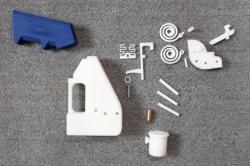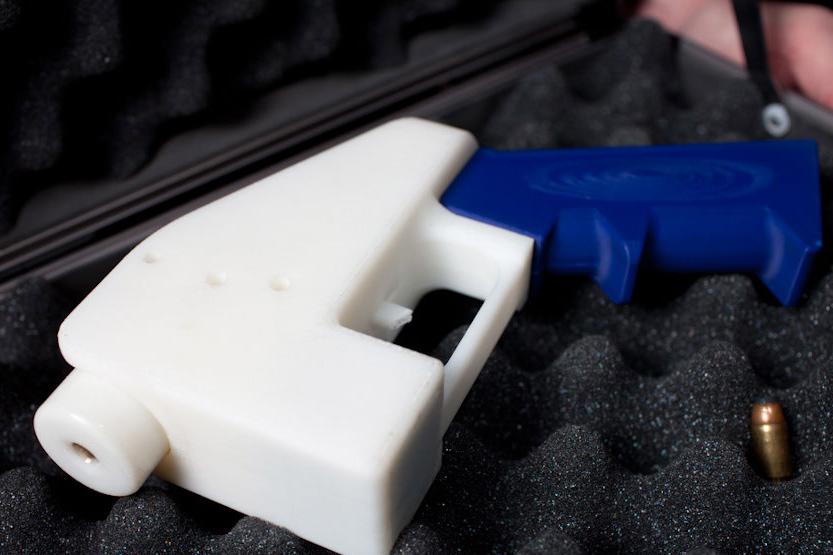This weekend, Forbes reported the successful test-firing of the world’s first 3-D–printed handgun. The weapon, a plastic handgun that fires .380-caliber bullets, has been long in the making. For more than a year, Cody Wilson, a law student and self-described “crypto-anarchist,” has been trying to create what he and his allies call a “wiki weapon.”
This gun, in Wilson’s description, will exist as much online as it does in the real world. “What we’re interested in producing is a digital file … containing the information for a 3D-printable weapons system,” Wilson announced in a fundraising pitch last summer. “As long as there’s a free Internet, that file is available to anyone at any time, all over the world.” After downloading the file, you need to feed it to a 3-D printer, a device that constructs a three-dimensional object according to computer-aided design specs. You’ll also need to use a common hardware-store nail as a firing pin—as Wilson explained to my colleague Will Oremus, the plastic pins they tried “were a little too soft.” Add that one metal part and, voila, outside the control of any authorities, you’d have yourself a gun. “A gun could be anywhere,” as Wilson explained in his pitch video. “Any bullet is now a weapon.”
For Wilson, creating a working gun is only an incidental aim. “What’s great about the wiki weapon is that it only needs to be lethal once,” he has said. That’s because the 3-D–printed gun’s real purpose is to provoke debate. Wilson argues that once printable guns become a reality, they’ll make all gun control efforts moot. Wilson and his allies take it for granted that in the Internet age, information is the one resource that is beyond the control of governments. Authorities may be able to take away your gun, but they can’t delete the plans for the gun. For gun advocates, the beauty of the 3-D weapon is that it shifts gun control from a fight centered on the Second Amendment to one focused on the First. It brings gun advocates into common cause with other global activists who are pushing for all manner of information to flow freely—document-leakers like Julian Assange, copyright fighters like the Pirate Bay, currency libertarians who favor alternative monetary systems (e.g., bitcoin), and Internet-abetted freedom fighters from Syria to Iran to China.
Don’t fall into Wilson’s trap. Though it’s a clever stunt, the printable gun does nothing to weaken the case for gun control—and, in the long run, it might well strengthen it. That’s because, for the foreseeable future, the printed gun can’t compete with manufactured weapons. It’s more expensive, less durable, and a worse shot than any gun you can buy from a store. At best, then, it’s a distraction from the mainstream politics of gun control. And so people who are concerned about gun violence should continue to focus on the real guns that are available now. It makes more sense to worry about printable ones later on, if they ever become a threat.
To see why, let’s look at the numbers. In 2011, according to the research firm Wohlers Associates, 6,500 large professional-grade 3-D printers were sold, along with 23,000 cheaper, “personal” machines. (Wilson’s gun prototype required a professional machine.) Wohlers estimates that the industry will more than double by 2020, with sales topping $5 billion a year, and printers getting much cheaper and more widely available. At some point, people in the industry have speculated, 3-D printers will cost less than $500 and people will buy millions a year.
That sounds big. But it’s small compared to the gun industry. There are an estimated 310 million non-military firearms in the United States. In 2012 alone, gun makers created 6 million new guns, with sales estimated at close to $12 billion. With so many cheap guns available, 3-D guns don’t warrant much attention. Sure, 3-D printers will get cheaper and better, but they aren’t anywhere near as cheap nor as widely available as manufactured guns, and they won’t be for many years. Until then, there are plenty of non-printable firearms to worry about.
But imagine what would happen if 3-D guns did take off and became a viable alternative to mass-manufactured firearms. What would that do to the gun industry, the leading financial supporter of the political opposition to gun control?
When music went digital, sales of physical media plummeted and piracy became rampant, draining the profits of the major record companies. With his 3-D gun plans—which he’s making available online for free—Wilson could bring about the same forces in the gun industry. If you can make your gun at home for just the price of plastic, why would you ever buy a real weapon? And if the 3-D gun starts to look like a real alternative, why would the weapons industry support this disruptive new enterprise? Wouldn’t gun manufacturers instead fight the rise of printable guns—perhaps by advocating the same tough laws that Hollywood has successfully pushed against file-sharers?

Courtesy of Defcad
And that gets to the 3-D gun movement’s fundamental error—their belief that information can’t be controlled, and that its mere existence will somehow force gun control advocates to rethink their approach. That simply isn’t true. Though the Internet has made all kinds of information more widely accessible, governments have proven adept at curbing all kinds of data they want to keep under wraps. A file containing instructions for a 3-D gun won’t help you much in North Korea, Syria, or Iran; there, where the governments have the ability to completely cut off the Internet and limit sophisticated machines like 3-D printers, you’ll be much better off getting a real gun.
Even non-repressive regimes can impose harsh penalties to limit the spread of certain information. The United States couldn’t stop WikiLeaks from distributing secret diplomatic cables, but it did manage to strike a terrible blow to the group when it cut off its funding sources. In the same way, by imposing strict penalties for the distribution and possession of child pornography, Western governments have severely limited its spread online.
The rise of file-sharing seems to support the 3-D gun movement’s claims—people share movies and songs illegally online, and no government has been able to stop them. But note that doing so isn’t completely safe; if the authorities set their mind to it, they can bankrupt you for sharing songs online. Countries where guns are already strictly curbed could impose similarly harsh measures against the distribution of plans for 3-D guns—and if they enforce them strictly, they might well limit their availability.
It’s not out of the question that such measures could be imposed in the United States, too. If 3-D printers were accessible enough that it became easy for felons, the mentally ill, and kids to make their own guns—especially if those weapons were undetectable by metal detectors—3-D guns would quickly be considered a dangerous public menace. If the gun lobby didn’t support these weapons, either, it’s conceivable that lawmakers would impose severe restrictions on the 3-D printer industry, which, of course, isn’t protected by the Second Amendment. Lawmakers could require 3-D printer manufacturers to prevent their machines from printing certain files—in the same way your DVD player can’t play movies from a different region—and impose harsh penalties for circumventing those rules. They could even make you register your printer the way you’ve got to register your car. Mind you, I’m not suggesting that the governments should fight 3-D–printed guns the way they’ve gone after child porn or even pirated movies. I’m just pointing out the folly of the 3-D gun movement’s rhetoric—the idea that, because 3-D guns might be available, their spread is unstoppable. That’s plainly untrue.
Finally, I wonder why Cody Wilson needs a 3-D gun to prove that we live in a world where information is tantamount to weaponry. We all know that we already live in such a world. Last week, before you could download plans for a workable 3-D–printed gun, you could find plans for all kinds of other weapons online—bombs, poisons, bioweapons, and many other horrors. We’ve just seem a terrible demonstration of this fact: Dzhokhar and Tamerlan Tsarnaev are alleged to have created the pressure-cooker bombs they used to attack the Boston Marathon by using off-the-shelf parts and plans published by Inspire, an al-Qaida–affiliated online magazine.
Note what happened to Samir Khan, the American behind Inspire: The U.S. government killed him in a drone strike. What’s more, no one sees the Boston bombing as a sign that we should forget about controlling traditional explosives—the fact that al-Qaida published bomb plans online doesn’t mean we should stop worrying about bombs that can be produced without online guidance. To suggest so would be ridiculous. That same logic applies to printable guns. Sure, they may be a threat someday, when they are as cheap and easy to produce as any other printout. But today, and for some time to come, the digital plan for the 3-D–printed gun is a lot like Inspire’s recipe for a pressure-cooker bomb. Even after you get the plan, you need special equipment, know-how, and determination to implement it, and most people aren’t going to have all the ingredients necessary to make these weapons viable.
